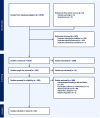Dumping Syndrome and Bile Acid Reflux Following Pyloroplasty and Gastric Peroral Endoscopic Myotomy (G-POEM) for Refractory Gastroparesis: A Systematic Review
- PMID: 40104464
- PMCID: PMC11914853
- DOI: 10.7759/cureus.79056
Dumping Syndrome and Bile Acid Reflux Following Pyloroplasty and Gastric Peroral Endoscopic Myotomy (G-POEM) for Refractory Gastroparesis: A Systematic Review
Abstract
Treatment options for medication- and diet-resistant gastroparesis include drainage procedures such as pyloroplasty and gastric peroral endoscopic myotomy (G-POEM). While dumping syndrome (DS) and bile acid gastritis (BAG) have been documented as complications following pyloric drainage procedures, limited evidence exists concerning their incidence after pyloroplasty and G-POEM for refractory gastroparesis. We performed a systematic review of outcomes following pyloroplasty and G-POEM for refractory gastroparesis (PROSPERO: CRD42024559654). PubMed, Embase, Cochrane, and Web of Science databases were systematically searched for articles reporting rates of DS and BAG following pyloric drainage procedures. Assessed outcomes included rates of DS and BAG. Results were narratively synthesized and presented descriptively. Of the 2278 records reviewed, 10 studies were included. Six studies evaluated pyloroplasty, and four studies evaluated G-POEM. Nine studies reported incidence of DS, and two studies reported rates of BAG. The incidence of DS ranged from 0% to 23.1%, with a median incidence of 3.23% and an interquartile range of 6.95% among nine studies. The incidence of BAG ranged from 0% to 15.4% in two studies. The studies displayed high heterogeneity in study design, patient population, and co-interventions, precluding collective data analysis and limiting generalizability. All studies displayed a moderate to serious risk of bias. There exists a paucity of data regarding the incidence of DS and BAG following pyloroplasty and G-POEM for refractory gastroparesis. Despite the theoretical association of these complications with pylorus-modifying procedures, our findings suggest that they may be uncommon or underreported in the treatment of refractory gastroparesis. Improved reporting of these outcomes and robust prospective studies investigating the incidence of such complications are required.
Keywords: bile acid gastritis; bile acid reflux; dumping syndrome; gastric peroral endoscopic myotomy; gastroparesis treatment; gpoem; pyloroplasty.
Copyright © 2025, Shargo et al.
Conflict of interest statement
Conflicts of interest: In compliance with the ICMJE uniform disclosure form, all authors declare the following: Payment/services info: All authors have declared that no financial support was received from any organization for the submitted work. Financial relationships: Joseph A. Sujka declare(s) personal fees from Entera Medical. Dr. Sujka is a consultant for Entera Medical. Joseph A. Sujka declare(s) personal fees from Medtronic. Dr. Sujka is a consultant for Medtronic. Joseph A. Sujka declare(s) personal fees from Intuitive Surgical. Dr. Sujka is a consultant for Intuitive Surgical. Other relationships: All authors have declared that there are no other relationships or activities that could appear to have influenced the submitted work.
Figures
Similar articles
-
Suspected bile acid gastritis and dumping syndrome after pyloric drainage procedures: experience from a tertiary care center.J Gastrointest Surg. 2025 Sep;29(9):102140. doi: 10.1016/j.gassur.2025.102140. Epub 2025 Jul 2. J Gastrointest Surg. 2025. PMID: 40614929
-
Pyloric drainage interventions for gastroparesis: a comparison of laparoscopic pyloroplasty and gastric peroral endoscopic myotomy (G-POEM) outcomes.Surg Endosc. 2025 Jun;39(6):3514-3524. doi: 10.1007/s00464-025-11731-3. Epub 2025 Apr 18. Surg Endosc. 2025. PMID: 40251315 Free PMC article.
-
Clinical efficacy of gastric per-oral endoscopic myotomy (G-POEM) in the treatment of refractory gastroparesis and predictors of outcomes: a systematic review and meta-analysis using surgical pyloroplasty as a comparator group.Surg Endosc. 2020 Aug;34(8):3352-3367. doi: 10.1007/s00464-019-07135-9. Epub 2019 Oct 3. Surg Endosc. 2020. PMID: 31583465
-
Predictors of favorable outcome after pyloroplasty for gastroparesis: should response to pyloric dilation or Botox injection be used as a marker of surgical outcome?Surg Endosc. 2023 Jun;37(6):4360-4369. doi: 10.1007/s00464-023-09882-2. Epub 2023 Feb 7. Surg Endosc. 2023. PMID: 36749378 Free PMC article.
-
Gastric Peroral Endoscopic Pyloromyotomy Therapy for Refractory Gastroparesis.Curr Treat Options Gastroenterol. 2017 Dec;15(4):637-647. doi: 10.1007/s11938-017-0156-9. Curr Treat Options Gastroenterol. 2017. PMID: 29030799 Review.
Cited by
-
Endoscopic treatment modalities for the management of gastroparesis: a critical review.Ann Gastroenterol. 2025 Jul-Aug;38(4):353-363. doi: 10.20524/aog.2025.0982. Epub 2025 Jun 30. Ann Gastroenterol. 2025. PMID: 40697438 Free PMC article. Review.
References
-
- United European Gastroenterology (UEG) and European Society for Neurogastroenterology and Motility (ESNM) consensus on gastroparesis. Schol J, Wauters L, Dickman R, et al. United European Gastroenterol J. 2021;9:287–306. - PubMed
-
- How to interpret gastric emptying scintigraphy. Seok JW. https://pubmed.ncbi.nlm.nih.gov/21602998/ J Neurogastroenterol Motil. 2011;17:189–191. - PMC - PubMed
-
- Comparison of gastric emptying of a nondigestible capsule to a radio-labelled meal in healthy and gastroparetic subjects. Kuo B, McCallum RW, Koch KL, et al. Aliment Pharmacol Ther. 2008;27:186–196. - PubMed
-
- Epidemiology, etiology, and treatment of gastroparesis: real-world evidence from a large US national claims database. Ye Y, Yin Y, Huh SY, Almansa C, Bennett D, Camilleri M. https://doi.org/10.1053/j.gastro.2021.09.064. Gastroenterology. 2022;162:109–121. - PubMed
Publication types
LinkOut - more resources
Full Text Sources

